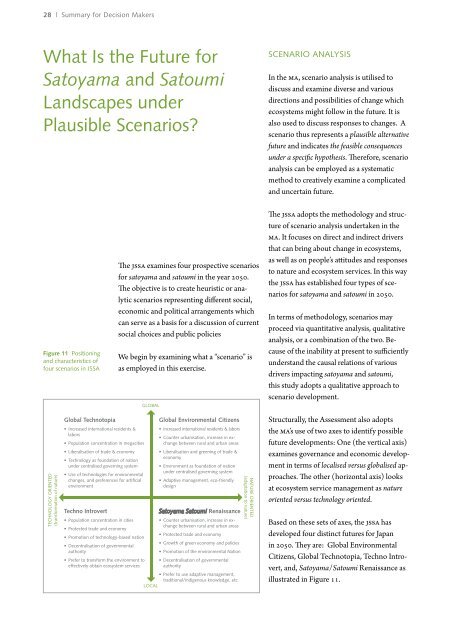Satoyama-Satoumi Ecosystems and Human Well-Being - UNU-IAS ...
Satoyama-Satoumi Ecosystems and Human Well-Being - UNU-IAS ...
Satoyama-Satoumi Ecosystems and Human Well-Being - UNU-IAS ...
Create successful ePaper yourself
Turn your PDF publications into a flip-book with our unique Google optimized e-Paper software.
28 | Summary for Decision Makers<br />
What Is the Future for<br />
<strong>Satoyama</strong> <strong>and</strong> <strong>Satoumi</strong><br />
L<strong>and</strong>scapes under<br />
Plausible Scenarios?<br />
Scenario analysis<br />
In the MA, scenario analysis is utilised to<br />
discuss <strong>and</strong> examine diverse <strong>and</strong> various<br />
directions <strong>and</strong> possibilities of change which<br />
ecosystems might follow in the future. It is<br />
also used to discuss responses to changes. A<br />
scenario thus represents a plausible alternative<br />
future <strong>and</strong> indicates the feasible consequences<br />
under a specific hypothesis. Therefore, scenario<br />
analysis can be employed as a systematic<br />
method to creatively examine a complicated<br />
<strong>and</strong> uncertain future.<br />
Figure 11 Positioning<br />
<strong>and</strong> characteristics of<br />
four scenarios in JSSA<br />
The JSSA examines four prospective scenarios<br />
for satoyama <strong>and</strong> satoumi in the year 2050.<br />
The objective is to create heuristic or analytic<br />
scenarios representing different social,<br />
economic <strong>and</strong> political arrangements which<br />
can serve as a basis for a discussion of current<br />
social choices <strong>and</strong> public policies<br />
We begin by examining what a “scenario” is<br />
as employed in this exercise.<br />
GLOBAL<br />
The JSSA adopts the methodology <strong>and</strong> structure<br />
of scenario analysis undertaken in the<br />
MA. It focuses on direct <strong>and</strong> indirect drivers<br />
that can bring about change in ecosystems,<br />
as well as on people’s attitudes <strong>and</strong> responses<br />
to nature <strong>and</strong> ecosystem services. In this way<br />
the JSSA has established four types of scenarios<br />
for satoyama <strong>and</strong> satoumi in 2050.<br />
In terms of methodology, scenarios may<br />
proceed via quantitative analysis, qualitative<br />
analysis, or a combination of the two. Because<br />
of the inability at present to sufficiently<br />
underst<strong>and</strong> the causal relations of various<br />
drivers impacting satoyama <strong>and</strong> satoumi,<br />
this study adopts a qualitative approach to<br />
scenario development.<br />
TECHNOLOGY ORIENTED<br />
(transformation of nature)<br />
Global Technotopia<br />
• Increased international residents &<br />
labors<br />
• Population concentration in megacities<br />
• Liberalisation of trade & economy<br />
• Technology as foundation of nation<br />
under centralised governing system<br />
• Use of technologies for environmental<br />
changes, <strong>and</strong> preferences for artificial<br />
environment<br />
Global Environmental Citizens<br />
• Increased international residents & labors<br />
• Counter urbanisation, increase in exchange<br />
between rural <strong>and</strong> urban areas<br />
• Liberalisation <strong>and</strong> greening of trade &<br />
economy<br />
• Environment as foundation of nation<br />
under centralised governing system<br />
• Adaptive management, eco-friendly<br />
design<br />
Techno Introvert<br />
<strong>Satoyama</strong> <strong>Satoumi</strong> Renaissance<br />
• Population concentration in cities<br />
• Counter urbanisation, increase in exchange<br />
between rural <strong>and</strong> urban areas<br />
• Protected trade <strong>and</strong> economy<br />
• Protected trade <strong>and</strong> economy<br />
• Promotion of technology-based nation<br />
• Growth of green economy <strong>and</strong> policies<br />
• Decentralisation of governmental<br />
authority<br />
• Promotion of the environmental Nation<br />
• Prefer to transform the environment to • Decentralisation of governmental<br />
effectively obtain ecosystem services<br />
authority<br />
• Prefer to use adaptive management,<br />
traditional/indigenous knowledge, etc.<br />
LOCAL<br />
Nature Oriented<br />
(adaptation to nature)<br />
Structurally, the Assessment also adopts<br />
the MA’s use of two axes to identify possible<br />
future developments: One (the vertical axis)<br />
examines governance <strong>and</strong> economic development<br />
in terms of localised versus globalised approaches.<br />
The other (horizontal axis) looks<br />
at ecosystem service management as nature<br />
oriented versus technology oriented.<br />
Based on these sets of axes, the JSSA has<br />
developed four distinct futures for Japan<br />
in 2050. They are: Global Environmental<br />
Citizens, Global Technotopia, Techno Introvert,<br />
<strong>and</strong>, <strong>Satoyama</strong>/<strong>Satoumi</strong> Renaissance as<br />
illustrated in Figure 11.
















